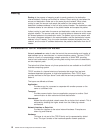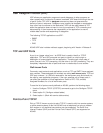
For additional information about sockets, see the
Sockets Programming
,
SC41-5422-03 book.
Send MIME Mail API
The Send MIME Mail API allows applications to use SMTP and TCP/IP to send mail
to the Internet.
Pascal API
The TCP/UDP programming interface was originally developed to provide system
programmers with a programming interface to the TCP or UDP protocols via a set
of procedure calls from an AS/400 Pascal program. This interface is no longer
documented in this publication because the AS/400 Pascal compiler is no longer
available. For information about the withdrawal of support for the Pascal compiler
see,
New Release Planning for V3R7
, SA41-4100.
The run-time support for the Pascal API is still included in the program product IBM
TCP/IP Connectivity Utilities for AS/400 (5769-TC1). Existing applications that use
the Pascal API can continue to be used. However, any new AS/400 TCP/IP
applications should use the sockets API.
Important Note:
Because of changes made to AS/400 TCP/IP in V3R1, pre-V3R1 TCP/IP
applications that use the Pascal API must be recompiled to function correctly
in V3R1 or later.
Multiprotocol Transport Networking Architecture
The Multiprotocol Transport Networking (MPTN) architecture implementation on
AS/400 allows Common Programming Interface Communications (CPI
Communications), intersystem communications function (ICF), and sockets to flow
over either TCP/IP, Systems Network Architecture (SNA), or Internetwork Packet
Exchange (IPX). On AS/400, the MPTN architecture is put into effect as AnyNet/400
support. For more information about AnyNet/400, see “AnyNet/400” on page 19.
Transport Protocol
This layer provides the end-to-end data transfer. This layer allows communication
between application programs. Example protocols that provide transport services
are Transmission Control Protocol (TCP) and User Datagram Protocol (UDP).
Transmission Control Protocol (TCP)
TCP is a widely used connection-oriented protocol that enables the transfer of data
from a source to a destination. TCP provides a reliable delivery of a stream of bytes
in sequence. TCP takes a stream of data, breaks it into segments (a TCP header
and application data), sends each one individually (using IP), and then reassembles
the segments back into the original stream. If any segments are lost or damaged
during the transmission, TCP detects this fact and resends the missing segments.
Most of the user application protocols, such as TELNET, FTP and SMTP, use TCP.
16 OS/400 TCP/IP Configuration and Reference V4R4


















